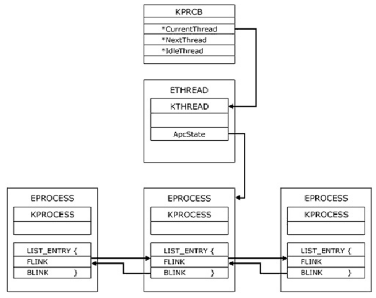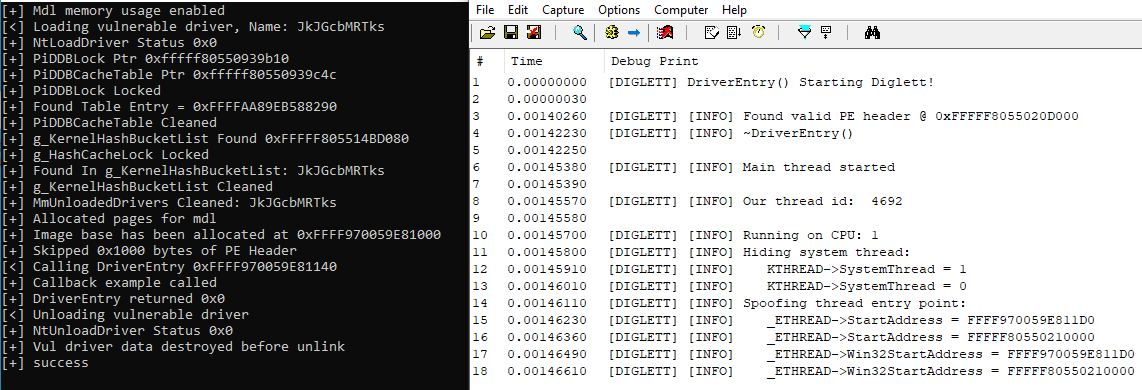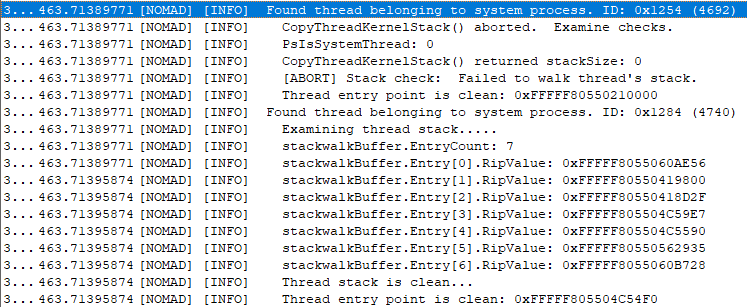System Thread Detection
Overview
Various anti-cheat vendors use several methods to detect cheats and prevent programs from modifying or tampering with the game process. This series will cover known heuristic methods being used today. Our topic will be in context with windows internals. Today this post is on detecting threads executing in Kernel memory. Lets dive in!
About Threads
First we will look at some undocumented structures used by ntoskrnl.exe. The (Kernel) Processor Control Block (KPRCB) is a struct that holds information for each logical processor. By reading the GS register, you can access the _ETHREAD / _KTHREAD struct of the currently executing thread on the logical processor.

struct _ETHREAD
{
struct _KTHREAD Tcb; //0x0
union _LARGE_INTEGER CreateTime; //0x600
union
{
union _LARGE_INTEGER ExitTime; //0x608
struct _LIST_ENTRY KeyedWaitChain; //0x608
};
union
{
struct _LIST_ENTRY PostBlockList; //0x618
struct
{
VOID* ForwardLinkShadow; //0x618
VOID* StartAddress; //0x620
};
... (etc.)
VOID* Win32StartAddress;
}
Here we see Tcb and Win32StartAddress which both hold some useful information about the thread in our case. Here’s an excerpt of _KTHREAD
struct _KTHREAD
{
struct _DISPATCHER_HEADER Header; //0x0
...
VOID* InitialStack; //0x28
VOID* volatile StackLimit; //0x30
VOID* StackBase; //0x38
ULONGLONG ThreadLock; //0x40
...
VOID* KernelStack;
...
}
Due to the nature of these structures being undocumented, the offsets can vary between windows versions. Signatures can be created though to find the correct offset locations. Above, we have KernelStack which holds a pointer to the threads’ stack. This will be used to determine if the thread is suspicious. Now we must enumerate through the threads. When using thread id’s, note that they are a multiple of 4. We also check to ensure that the thread belongs to the system process by getting the process id of the thread and comparing it to our thread’s process id.
// current process is the system process
thisEPROC = pPsGetCurrentProcess();
for (size_t currentThreadId = 4; currentThreadId < 0x5000; currentThreadId += 4)
{
status = pPsLookupThreadByThreadId((HANDLE)currentThreadId, &threadObject);
processObject = pIoThreadToProcess(threadObject);
processID = pPsGetProcessId(processObject);
if (processID == systemProcId)
// do checks...
}
We shouldn’t try to copy a thread’s stack while it’s executing as the stack will constantly be changing. The thread needs to be in a Waiting state. To do this safely, we first acquire a lock to the thread. This means that as we enumerate the threads, we have to skip stack examination of threads that are not Waiting.
BOOL Utility::LockThread(_In_ PKTHREAD Thread, _Out_ KIRQL * Irql)
{
KIRQL currentIrql;
UINT64 ThreadLockOffset;
KSPIN_LOCK* threadLock;
if (Thread && Irql)
{
ThreadLockOffset = GetThreadLockOffset();
threadLock = (PKSPIN_LOCK)((BYTE*)Thread + ThreadLockOffset);
if (threadLock && ThreadLockOffset)
{
currentIrql = KeGetCurrentIrql();
// set cr8[3:0] (interrupt mask)
__writecr8(0xC);
*Irql = currentIrql;
// raise our IRQL so our thread doesn't get interrupted
KeAcquireSpinLockAtDpcLevel(threadLock);
currentIrql = KeGetCurrentIrql();
return SUCCESS;
}
else
{
return FAIL;
}
}
else
{
return FAIL;
}
}
If the thread is in a Running state, locking it won’t halt the thread. This is why we need to check if the thread is in a waiting state after its been locked. You could use NtSuspendThread and NtResumeThread to change the thread’s state. However, this is probably ill-advised for system stability concerns. The State member in _KTHREAD holds the thread’s current state. To find the offset, we can scan for it in a function that references it. KeAlertThread seems like it would need to access that member. Knowing the correct offset already and then loading ntoskrnl.exe into Ghidra, we can quickly see where this function accesses this member


The offset value here is 0x184. Now it’s trivial to write a function to pattern match the bytes at this instruction and pull the offset bytes. Here’s a quick and dirty example
BOOLEAN threadStatePatternMatch(_In_ BYTE* address, _Inout_ UINT32** outOffset, _In_ UINT32 range)
{
for (BYTE* currByte = address; currByte < (address + range); currByte++)
{
if (currByte[0] == threadStatePattern[0]
&& currByte[1] == threadStatePattern[1]
&& currByte[6] == threadStatePattern[6]
&& currByte[7] == threadStatePattern[7])
{
*outOffset = (UINT32*)((BYTE*)currByte + 2);
return SUCCESS;
}
}
return FAIL;
}
Here’s the checks the thread needs to pass in order to be examined
if (isSystemThread // is a system thread
&& (kernelStack > stackLimit) // kernel stack is within bounds of stack size
&& (kernelStack < stackBase) // stack grows downward
&& *(threadStateOffset + threadObject) == KTHREAD_STATE::Waiting // thread is waiting
&& (PKTHREAD)threadObject != KeGetCurrentThread()) // the thread isn't ours
{
StackWalkThread(threadObject, &stackBuffer);
}
Two key functions can be used for unwinding the stack to get the proper rip / rsp values from each frame: RtlLookupFunctionEntry and RtlVirtualUnwind. The first rip should be within the address range of ntoskrnl since that’s where threads are created from.
if (startRip >= ntosTextBase && startRip < ntosTextBase + sectionVa)
{
context->Rip = startRip;
context->Rsp = (DWORD64)(stackBuffer + 8);
for (size_t i = 0; i < 0x20; i++)
{
rip = context->Rip;
rsp = context->Rsp;
stackwalkBuffer->Entry[stackwalkBuffer->EntryCount].RipValue = rip;
stackwalkBuffer->Entry[stackwalkBuffer->EntryCount++].RspValue = rsp;
if (rip < (UINT64)MmSystemRangeStart || rsp < (UINT64)MmSystemRangeStart)
break;
functionTableEntry = pRtlLookupFunctionEntry(rip, (PDWORD64)&moduleBase, 0);
if (!functionTableEntry)
break;
pRtlVirtualUnwind(0, moduleBase, context->Rip, functionTableEntry, context, (PVOID*)&handlerData, (PDWORD64)&establisherFrame, 0);
if (!context->Rip)
{
stackwalkBuffer->Succeeded = 1;
break;
}
}
}
Now unlock the thread so it’s free to be scheduled again.
threadLockOffset = GetThreadLockOffset();
threadLock = (KSPIN_LOCK*)((BYTE*)threadObject + threadLockOffset);
if (threadLockOffset)
{
if (threadLock != 0)
{
KeReleaseSpinLockFromDpcLevel(threadLock);
__writecr8(oldIrql);
}
}
Detecting Suspicious Threads
Taking the previous information, we can simply use ZwQuerySystemInformation with class SystemModuleInformation to enumerate all the system modules and compare the address ranges to the values in the stacks we are examining. If any of thread’s rip or rsp values lie outside of the legit module ranges, we can flag this as suspicious behavior. Below is a simple way to check.
BOOLEAN CheckModulesForAddress(UINT64 address, PRTL_PROCESS_MODULES systemMods)
{
RTL_PROCESS_MODULE_INFORMATION sysMod;
for (size_t i = 0; i < systemMods->NumberOfModules; i++)
{
sysMod = systemMods->Modules[i];
if ((UINT64)sysMod.ImageBase < address && address < ((UINT64)sysMod.ImageBase + sysMod.ImageSize))
{
return SUCCESS;
}
}
return FAIL;
}
Without relying on the stack, we can also get the thread’s start address by simply getting the Win32StartAddress value in _ETHREAD using NtQueryInformationTHread like so
NTSTATUS Utility::GetThreadStartAddr(_In_ PETHREAD threadObject, _Out_ uintptr_t* pStartAddr)
{
*pStartAddr = NULL;
HANDLE hThread;
NTSTATUS status;
if (!NT_SUCCESS(status = ObOpenObjectByPointer(threadObject, OBJ_KERNEL_HANDLE, nullptr, GENERIC_READ, *PsThreadType, KernelMode, &hThread))) {
LogError("ObOpenObjectByPointer failed.\n");
return status;
}
uintptr_t startAddr = NULL;
ULONG returnedBytes;
if (!NT_SUCCESS(status = pNtQueryInformationThread(hThread, ThreadQuerySetWin32StartAddress, &startAddr, sizeof(startAddr), &returnedBytes))) {
LogError("NtQueryInformationThread failed.\n");
NtClose(hThread);
return status;
}
*pStartAddr = startAddr;
NtClose(hThread);
return STATUS_SUCCESS;
}
Now that we know how to examine a thread and deem it suspicious, we could do further analysis to decide our actions which will be covered in a later article. Lets move on to how these methods could be mitigated.
Mitigations
We can circumvent the system thread check by clearing the SystemThread bit in _KTHREAD which identifies our thread type. The entry point can be changed as well. We can change the StartAddress
thisKThread = reinterpret_cast<PKTHREAD>(KeGetCurrentThread());
thisKThread->SystemThread = 0;
_ETHREAD* myEThread = reinterpret_cast<_ETHREAD*>(thisThread);
myEThread->StartAddress = (PVOID)newWin32StartAddr;
myEThread->Win32StartAddress = (PVOID)newWin32StartAddr;
Below on the right is output from project Diglett that currently does its best to evade and hide from anti-cheat software’s heuristic detection methods. To the left, those familiar will notice a very popular mapper is being used to manually map Diglett.

Below is the scan output from project Nomad which currently implements all the above checks, and also has additional checks for threads starting from pool allocations. Here we can see Diglett successfully spoofed its thread information.

Conclusion
This is just one technique for using heuristics to profile running programs that have suspicious behavior. The focus here was for threads running in the context of the System process. This is useful for manually mapped drivers that avoid communication to user-land and perform all their functionality in kernel. The next article will focus on memory detection methods. Thanks for reading!
